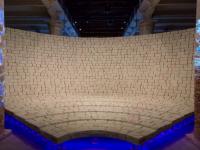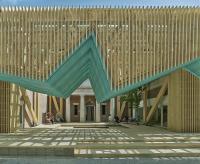Kunstmuseum Basel
Basel, Switzerland
With Kunstmuseum Basel's new building, a prominent location in inner-city Basel has been reclaimed. The extended museum comprises two directly interrelating buildings on opposite sides of the street. The actual link between the main building and the new building beneath the street is not an underpass, but an extensive spatial structure that leads to a large hall at the bottom of the main steps. Each floor of the new building accommodates two exhibition wings that are vertically interconnected by the monumental flight of steps. Prefabricated sand-blasted concrete elements span the exhibition rooms as visible structural components, giving the ceilings a distinctive structure and giving the space a direction.
The facade, an archaic-looking grey brick wall with timeless character, is designed as self-supporting monolithic masonry. Much like the main building's facade, the new building's facade also appears to have the classical partitioning of base, body and top, due to the stones' different light hues and the relief. The new building and the main building speak the same language, but tell different stories.
The new building's angular compact body is built as a solid construction. The structure reveals its load-bearing capacity via its spatial arrangement. The concrete walls of the exhibition spaces on the 1st and 2nd floors act as slabs and bridge the large halls on the ground floor. The ceilings on the ground floor and 1st floor are realised with sophisticated prefabricated ribbed ceiling elements. Left as raw exposed concrete, they hang from the ground floor's concrete walls and rest on the 1st floor's concrete walls. Funnel-shaped prefabricated skylight elements span the rooms on the 2nd floor.
The outer wall has a double skin and comprises an inner, load-bearing, reinforcing concrete wall and an outer brick facade in front. The distance between them is 28 cm (24 cm of insulation and 4 cm of empty space). Horizontally and vertically movable anchors between the inner and outer skins, as well as ductile facade corners, make the seamless masonry facade possible, enhancing the homogeneity of the building's appearance.
- Engineers
- ZPF Ingenieure
- Location
- St. Alban-Graben 16, 4051 Basel, Switzerland
- Year
- 2016
- Client
- Hochbau-und Planungsamt Basel-Stadt
- Architecture
- Christ & Gantenbein











